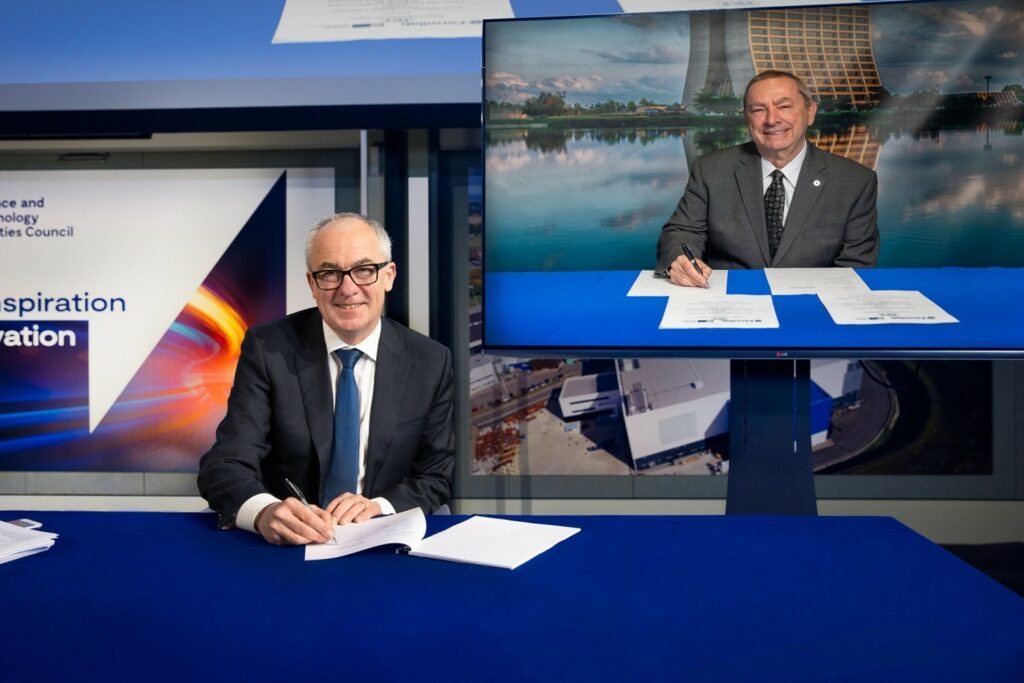STFC and Fermi National Accelerator Laboratory have agreed to collaborate on building one of the world’s most powerful linear accelerators.
Based at the US Department of Energy’s Fermilab, the Proton Improvement Plan-II (PIP-II) accelerator, currently under construction, is an essential upgrade to the accelerator complex. Once complete, it will enable the world’s most powerful high-energy neutrino beams.
The agreement sets out how the UK will contribute to the PIP-II accelerator project, which will provide the engine for the Deep Underground Neutrino Experiment (DUNE), as well as a suite of other experiments hosted by Fermilab. DUNE is an international flagship science experiment designed to study neutrinos. Results from these studies could potentially revolutionise our understanding of the universe.
The agreement was signed by STFC’s Executive Chair, Professor Mark Thomson and the Director of Fermilab, Dr Nigel Lockyer.

Professor Mark Thomson said: “Today’s agreement further strengthens the UK’s collaboration with our US partners in this crucial project, which sits at the heart of a new globally significant facility at Fermilab.”
The UK’s involvement in the upgrade has been made possible through the UK government’s £79 million investment in the DUNE experiment, Long-Baseline Neutrino Facility (LBNF), and the new PIP-II accelerator.
The investment delivered by STFC has given UK scientists and engineers, many of them based at the Cockcroft Institute, the chance to take leading roles in the management and development of the DUNE far detector, the LBNF neutrino beam targetry and PIP-II accelerator.
STFC will design, build and qualify vital elements of the 215-metre-long particle accelerator, which will accelerate the proton beam to its highest energy. The main elements currently being developed by Cockcroft Institute scientists at Daresbury Laboratory are the cryomodules for the superconducting Radio Frequency (SRF) cavities.
SRF cavities store the energy needed to accelerate the proton beam, which when fired into a carbon or beryllium target, will produce a high-intensity beam of neutrinos.
The cavities are made from niobium, which is both malleable and is superconducting at low temperature. However, it is not an easy material to work with as it reacts with oxygen in the air at high temperatures, especially during the welding process.
STFC has been working closely with industry partner, The Welding Institute (TWI) in Cambridge, which has commissioned the UK’s first Electron Beam Welder able to weld in vacuum the high-purity niobium cavities.
Teams of scientists, engineers and technicians from the Cockcroft Institute and Daresbury Laboratory, working with TWI, will construct three cryomodules, each housing six SRF cavities.
Once the cryomodules are built, each of them will need to be safely transported to Fermilab in the US. The transport frame has to protect the cryomodule and all of its high-tech components during transportation.
Professor Peter McIntosh, PIP-II Principal Investigator and Deputy Director of ASTeC at the Cockcroft Institute, said: “The UK, STFC and Daresbury Laboratory in particular, have a fantastic opportunity to provide cutting-edge accelerator technologies for ‘powering the heart’ of the international flagship project LBNF/DUNE in the USA. I am immensely proud of how the delivery team at Daresbury, along with our industry partners, have adapted to the challenges faced in developing our leading provision of Superconducting cryomodules for PIP-II.”
